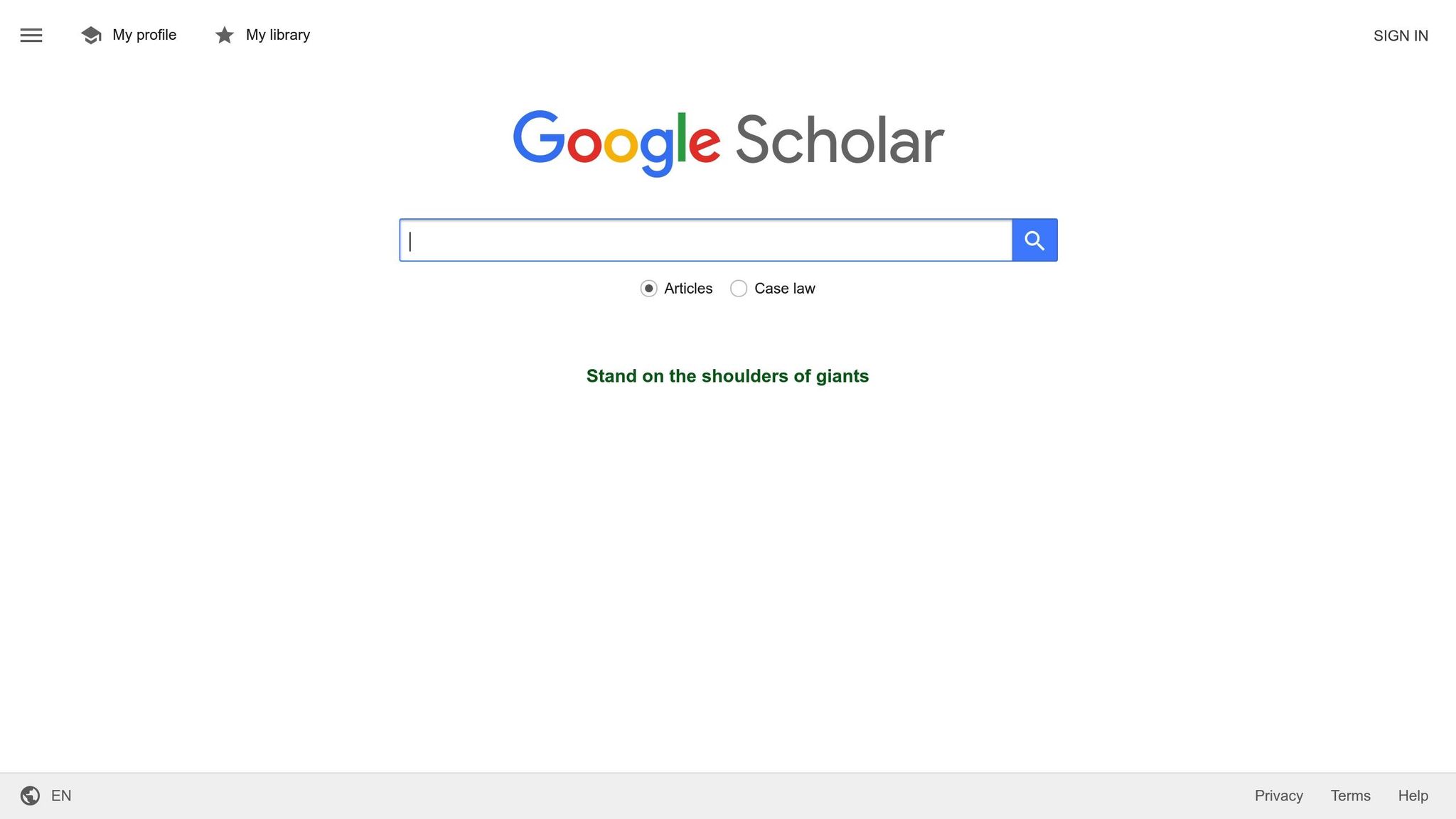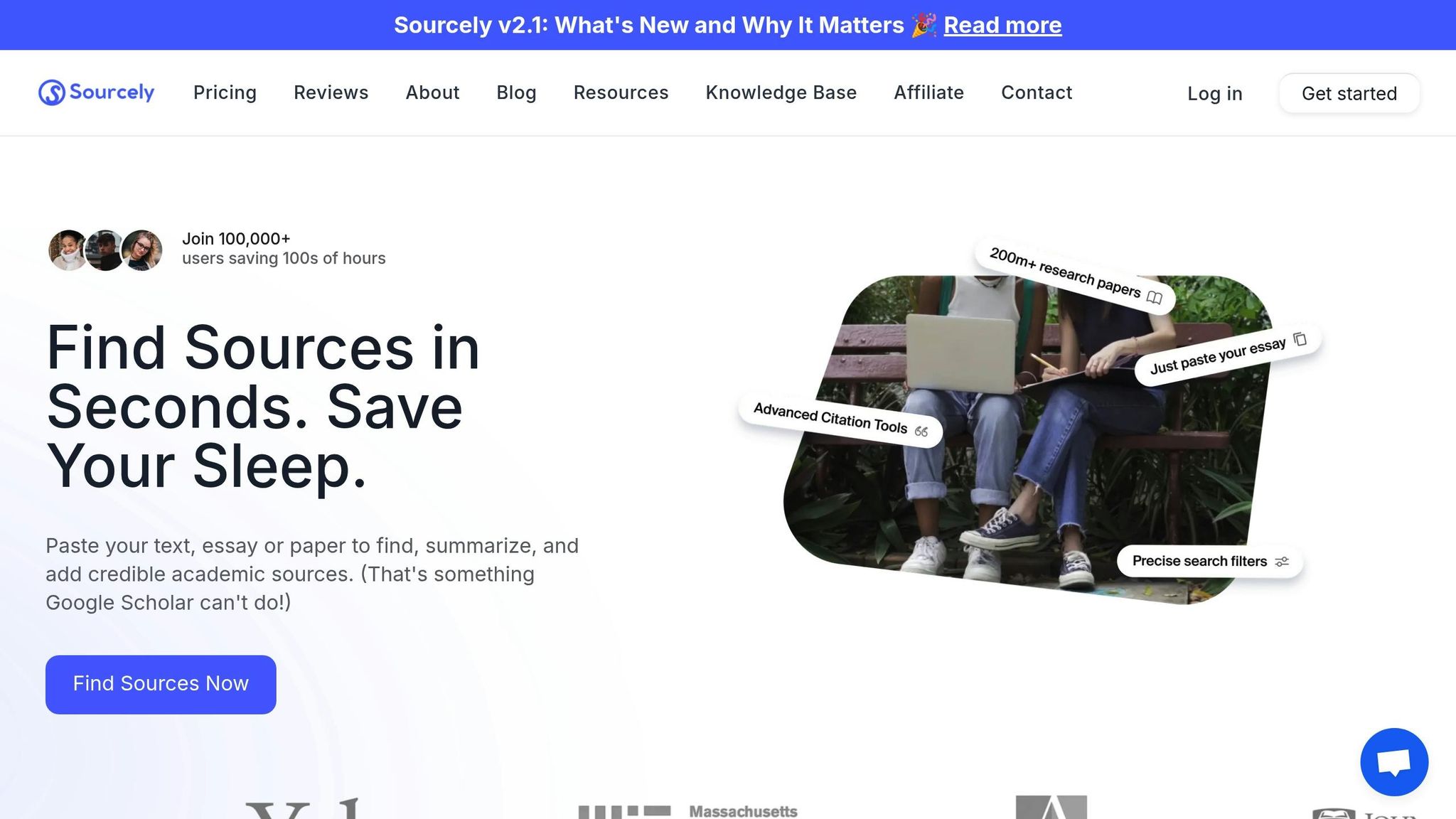
The Ultimate Guide to Finding Peer-Reviewed Articles in Minutes
Finding peer-reviewed articles can feel like a daunting task, but it doesn’t have to be. Peer-reviewed articles are essential for academic research because they’re rigorously evaluated by experts, ensuring high-quality information. Yet, challenges like time-consuming searches, complex databases, and paywalls often slow researchers down.
Here’s the solution: AI tools like Sourcely simplify this process. Sourcely uses advanced algorithms to locate reliable peer-reviewed sources in minutes, saving you hours of manual searching. It even provides features like citation management, free PDF access, and detailed metadata to streamline your workflow.
Key Takeaways:
- What are peer-reviewed articles? Scholarly works reviewed by experts for accuracy and quality before publication.
- Why are they hard to find? Limited access, confusing databases, and time-intensive searches.
- How can AI help? Tools like Sourcely quickly identify and verify peer-reviewed sources, cutting search time by up to 70%.
Sourcely offers flexible plans, from a free version for basic needs to lifetime access for frequent researchers. Whether you’re a student or a professional, this tool can transform how you approach academic research.
How To Find Peer-Reviewed Articles On Google Scholar? - CountyOffice.org

What Are Peer-Reviewed Articles
Peer-reviewed articles are often considered the benchmark for quality in academic research, but distinguishing them from other types of scholarly content can sometimes be a challenge.
Definition of Peer-Reviewed Articles
A peer-reviewed article is a scholarly work that undergoes a thorough evaluation by experts in the same field before it gets published. This process ensures the research meets high standards for quality, validity, and scientific accuracy.
Here’s how it works: when a manuscript is submitted, it’s sent to independent reviewers who specialize in the topic. These experts scrutinize the research methodology, data analysis, conclusions, and overall contribution to the field. Based on their evaluation, reviewers provide detailed feedback and recommend whether the article should be accepted, revised, or rejected. To maintain fairness, the reviewers often don’t know the author’s identity, which helps ensure the work is judged solely on its content rather than the author’s reputation or institutional ties.
The main goal of peer-reviewed articles is to contribute to the ongoing development of knowledge in a particular field. They often present original research, new data, or thoughtful positions on important questions. Simply put, these articles are research-backed and rigorously vetted - not just opinions.
Now, let’s look at how you can identify these articles with confidence.
How to Spot Peer-Reviewed Articles
Once you understand what peer-reviewed articles are, the next step is knowing how to recognize them. It’s not always obvious, especially when you’re pressed for time, but there are clear indicators that can help.
While all scholarly articles are written by experts for an audience of other experts, peer-reviewed articles go a step further by undergoing an additional layer of rigorous evaluation. This distinction can help you focus on the most reliable sources. Here are some tips for identifying peer-reviewed content:
- Check the journal’s editorial information. Peer-reviewed journals usually include details about their editorial board, review process, and submission guidelines on their websites. Many explicitly state their peer-review policies and timelines.
- Use database filters. Academic databases often have a "peer-reviewed only" or "scholarly/peer-reviewed" filter, which can save you time by excluding non-peer-reviewed materials from your search results.
- Consider the publication timeline. Peer-reviewed articles typically take months to publish due to the extensive review process, unlike popular or trade articles, which appear much faster.
- Look for standard academic sections. Peer-reviewed articles usually include sections like an abstract, introduction, methodology, results, discussion, and references. They also use formal, technical language aimed at a scholarly audience.
Using AI Tools to Speed Up Your Literature Search
Traditional literature searches can be a tedious process, often requiring hours of sifting through countless sources to determine their relevance and credibility. But with AI-powered tools, this entire process has been streamlined, allowing researchers to find high-quality academic sources in just minutes.
Unlike traditional methods that often overwhelm you with irrelevant results, AI tools analyze the context of your query and zero in on sources that directly support your research. This not only saves time but also ensures your work is backed by credible, relevant information. One such tool making waves in academic research is Sourcely.
How Sourcely Makes Academic Research Easier

Sourcely is an AI-driven platform specifically designed to simplify academic research. By leveraging advanced algorithms, it eliminates the hassle of manually verifying sources. The platform analyzes the context of your research and instantly identifies peer-reviewed articles from its extensive database of over 200 million research papers.
Instead of relying on broad keyword searches, you can input your research text directly into Sourcely. The AI processes your text, highlights sections that need citations, and matches them with peer-reviewed sources tailored to your argument.
What sets Sourcely apart is its exclusive focus on validated sources. Every article in its database comes from peer-reviewed journals or academic conferences, meaning you can trust the credibility of every result without additional verification.
"Our AI-powered source finding tool is built by students for students, and this approach allows us to create a tool that truly understands the needs of the academic community."
The numbers speak volumes - over 100,000 users are already saving significant time by incorporating Sourcely into their research workflow.
Main Features for Fast Research
Sourcely doesn’t just stop at finding sources; it’s packed with features to make your research process even smoother. Here’s a glimpse of what it offers:
- Text-Based Source Recommendations: Paste up to 2,000 characters of your research text, and Sourcely will provide targeted, citation-worthy sources.
- Advanced Search Filters: Narrow results by publication year, author, or relevance - ideal for pinpointing sources for contemporary studies or specific historical periods.
- Free PDF Access: Many sources come with free PDF downloads, saving you time and money.
- Citation Management: Sourcely formats your citations in APA, MLA, Chicago, or other styles commonly used in the U.S., simplifying your workflow.
- AI Summaries: Each source includes an AI-generated summary of key findings, so you can quickly decide whether it’s worth diving into the full article.
- Citations Library: Organize all your sources in one place and export them in your preferred citation format.
- Metadata Insights: Sourcely provides essential details like publication date, author credentials, journal reputation, and citation count, helping you assess credibility at a glance.
- Source Previews: The summary AI tool extracts relevant excerpts, letting you evaluate sources without opening multiple tabs.
With these features, Sourcely transforms what used to be a time-intensive task into a seamless process. By cutting down on research time and providing tools to stay organized, it ensures you can focus on what really matters: crafting your argument and advancing your academic work.
Step-by-Step Guide to Finding Peer-Reviewed Articles with Sourcely
Now that you're familiar with Sourcely's features, let’s go through the process of finding peer-reviewed articles quickly and effectively.
Getting Started with Sourcely
First things first - create your account and choose a plan. Head over to sourcely.net and sign up. You can start with the free plan, which doesn’t require a credit card.
Once you’re logged in, pick the access plan that suits your needs. Sourcely offers several options: a free plan to explore the platform, a one-time trial for $7.00, a monthly subscription at $17.00, an annual plan for $167.00, or a lifetime plan for $347.00 to unlock all features.
The interface is clean and intuitive. Right on the homepage, you’ll find the main search box where you can paste your research text or type in specific keywords. From here, you can refine your search using Sourcely's advanced filters.
Using Filters for Better Results
Sourcely’s advanced filters are a game changer for narrowing down your search results. Start by pasting your research text into the search box - up to 2,000 characters is plenty for a detailed query or research question. The AI will analyze your input and suggest highly relevant sources.
If you’re looking for the most up-to-date research, use the publication year filter to focus on recent studies. Alternatively, adjust the timeline to include older works if you’re diving into historical research. Subject filters are also available to exclude irrelevant fields and keep your results focused.
Be sure to activate the peer-reviewed filter to ensure that all your results come from verified academic sources. Sourcely’s relevance ranking automatically prioritizes articles that closely match your query, but you can also sort results by publication date to find the latest studies.
Once you’ve customized your search, you’re ready to download articles and organize your references.
Downloading Articles and Exporting References
After identifying the sources you need, Sourcely makes it simple to access and manage them. Most articles offer free PDF downloads, allowing you to quickly get the full text.
Need to cite your sources? Sourcely lets you export citations in a variety of formats, including APA, MLA, and Chicago. You can also download them as BibTeX, RIS, or plain text files, ensuring they’re compatible with your preferred reference management tool. Just select the articles you want, choose your citation style, and Sourcely will generate ready-to-use references for your bibliography.
With these tools, finding and managing peer-reviewed articles becomes a seamless part of your research process.
sbb-itb-f7d34da
Tips for Checking Source Quality and Accuracy
Ensuring the quality and accuracy of your sources is crucial for solid academic work. While finding peer-reviewed articles is an essential first step, verifying their reliability takes your research to the next level.
Confirming Peer-Reviewed Status
Sourcely exclusively provides content from verified peer-reviewed journals and academic conferences. But how can you double-check this? Start by examining the article's metadata. Journal names can be your first clue - well-known academic journals typically follow strict peer-review standards.
Next, look at the author credentials. Are the authors affiliated with respected universities or research institutions? Do they hold advanced degrees in their field? These details add credibility. The publication venue is another key factor. Conferences organized by reputable organizations like IEEE or ACM, often featured in Sourcely's results, maintain rigorous peer-review processes to ensure high-quality research.
Once you confirm the peer-reviewed status, take a moment to assess the article's influence by reviewing its citation count.
Checking Research Quality
After confirming publication credibility, dig deeper by evaluating citation metrics. Articles with higher citation counts often indicate significant scholarly impact, showing that the research has been widely acknowledged and utilized within its field.
Sourcely simplifies this process by offering tools that let you track and assess references in real time, making it easier to gauge the importance and relevance of a source.
Using Sourcely's Summary and Citation Tools
Sourcely goes beyond basic quality checks with features designed to streamline your research. It provides essential metadata like the publication date, author details, and journal reputation, all in one place. Sourcely also tracks citation counts, giving you a quick snapshot of an article's academic influence.
The platform’s summary tools highlight key findings and conclusions, helping you quickly determine a source's relevance and quality. Plus, its reference export options - offering formats such as APA, MLA, Chicago, BibTeX, and RIS - make it easy to integrate vetted sources into your reference management system without duplicating efforts.
As you incorporate these sources into your research, continue to critically evaluate their arguments, data clarity, and how well the conclusions align with the evidence presented. These steps ensure your work is built on a foundation of reliable and thoroughly vetted information.
Choosing the Right Plan for Your Needs
Selecting the best Sourcely plan depends on how often you conduct research, the scope of your projects, and your budget. With Sourcely’s user-friendly research tools, the right plan can make your work even more efficient. Whether you’re tackling occasional assignments or managing extensive research projects, there’s a plan tailored to your needs.
Comparing Sourcely's Free and Paid Plans
The free version of Sourcely allows search queries of up to 300 characters. While this is great for quick searches or short assignments, the character limit can restrict the depth of your research. This makes the free plan ideal for students working on smaller projects but less suitable for detailed research or thesis work.
Paid plans, on the other hand, offer expanded features and greater flexibility. Here’s a breakdown of what each plan includes:
| Plan | Price | Key Features |
|---|---|---|
| Free | $0 | Up to 300 characters, basic search functionality |
| Pro Trial | $7 | 2,000 characters, one-time payment to test Pro features |
| Monthly Pro | $17/month | Unlimited characters, advanced filters, PDF downloads |
| Annual Pro | $167/year | Same as Monthly Pro, but at a lower cost per month ($13.92) |
| Believer | $347 | Lifetime access to all Pro features |
The Pro Trial ($7) is a great way to see if Sourcely’s advanced features and increased character limit (up to 2,000) meet your needs. For those who use the platform regularly, the Annual Pro plan ($167) offers excellent value by cutting the monthly cost significantly. If you’re planning to rely on Sourcely for the long haul, the Believer plan ($347) provides lifetime access, making it the most budget-friendly option over time.
Maximizing Your Subscription
When choosing a plan, think about how often you’ll use Sourcely. If you’re a student working on a thesis or dissertation, the Annual Pro plan might be the most economical choice, as these projects often require months of research. For frequent users, the monthly plan ensures consistent access to advanced tools without a long-term commitment.
Occasional users can stick with the free version for basic searches, but serious researchers will find the paid plans save time and effort. Don’t forget to check for educational discounts if you’re affiliated with a school or university.
Ultimately, the key is to match your plan to your research habits. By choosing the right subscription, you’ll set yourself up for efficient, high-quality research with Sourcely.
Conclusion: Speed Up Your Research Process with Sourcely
Sourcely revolutionizes the way you find peer-reviewed articles, making the research process faster and more efficient. Thanks to its AI-driven platform, you can locate credible academic sources in just minutes, cutting down the time spent searching from hours to mere moments.
In fact, studies indicate that platforms like Sourcely can reduce the time spent on literature searches by up to 70%. Users often find relevant peer-reviewed articles in under 10 minutes, compared to the 30–60 minutes it typically takes with manual database searches. This time-saving advantage means you can focus more on analysis and writing, rather than sifting through endless search results. Sourcely even simplifies the process by filtering for peer-reviewed sources and allowing you to export citations effortlessly.
The platform’s effectiveness is evident in real-world scenarios. For instance, graduate students have reported cutting their literature search time from several hours to just 30 minutes. This kind of efficiency demonstrates how Sourcely can transform your research workflow.
To get the most out of Sourcely, start by clearly identifying your research question. Then, use its advanced filters to narrow results to peer-reviewed articles. Features like keyword and Boolean search options help you pinpoint exactly what you need. Plus, Sourcely’s ability to download articles and export citations automatically ensures a seamless experience from start to finish.
Whether you’re using the free plan for occasional searches or upgrading for unlimited access and advanced tools, Sourcely offers flexibility to match your research needs and budget. As your academic projects grow, you can scale your subscription to ensure you always have the right resources at your fingertips.
Not only does Sourcely save you time, but it also enhances the quality of your research by providing access to credible, peer-reviewed sources. By integrating Sourcely into your workflow, you uphold academic integrity while meeting the demands of modern research with ease.
FAQs
How does Sourcely confirm that the articles it finds are peer-reviewed?
Sourcely takes the guesswork out of finding reliable research by pulling content exclusively from well-established academic journals and databases with strict peer-review standards.
Its advanced search filters allow users to narrow down their results to include only peer-reviewed studies. This means you’re accessing information that’s been carefully vetted and reviewed by experts, ensuring it’s both trustworthy and accurate.
Why should I use Sourcely instead of traditional academic databases to find peer-reviewed articles?
Sourcely streamlines the process of finding peer-reviewed articles by offering AI-powered search tools that are far more user-friendly than traditional academic databases. With its straightforward interface, you can locate credible research in just a few clicks, skipping the hassle of navigating complex systems.
The platform also saves valuable time by providing access to free PDFs of academic papers and offering precise filters to tailor your search results. This combination ensures your research is not only quick but also highly accurate, allowing you to dedicate more energy to your actual work.
Does Sourcely help with managing citations, and how does it make the process easier?
Sourcely makes managing citations a breeze. It automatically identifies relevant sources, creates precise citations, and lets you export bibliographies in multiple formats. On top of that, it reviews your text to pinpoint areas needing citations and suggests reliable references. This way, you can ensure proper attribution with minimal hassle, keeping your research accurate and polished.